AI software for office work
In the digital age, AI software for office work is becoming the ultimate solution for businesses and individuals to boost productivity. These tools not only automate repetitive tasks but also support writing, data management, information analysis, and smarter team collaboration. By applying AI, office work becomes faster, more accurate, and time-saving, delivering a sustainable competitive advantage.
Artificial intelligence has rapidly become embedded in everyday office software, helping automate routine tasks and boost productivity. Industry research reveals that employees using AI-powered tools are 90% more likely to feel productive, saving an average of 3.6 hours per week.
Today's office suites and collaboration apps offer AI assistants for drafting text, analyzing data, scheduling, meeting transcription, and more. These intelligent tools are transforming how we work, making complex tasks simpler and freeing up time for strategic thinking.
Essential AI Tools Collection
Microsoft 365 Copilot
| Developer | Microsoft Corporation |
| Supported Platforms |
|
| Language Support | English, Spanish, Japanese, French, German, Portuguese, Italian, Simplified Chinese (more languages in development) |
| Pricing Model | Paid add-on requiring Microsoft 365 subscription. Copilot Pro: ~$20/user/month | Copilot for Microsoft 365: ~$30/user/month (annual) |
| Compliance | Enterprise-grade security with GDPR compliance and EU data residency support |
What is Microsoft 365 Copilot?
Microsoft 365 Copilot is an AI-powered productivity assistant embedded within the Microsoft 365 ecosystem. It combines your organizational data—documents, emails, chats, calendar items—via Microsoft Graph with advanced large language models (LLMs) to provide contextual, real-time assistance across all your Microsoft 365 applications.
With natural language prompts, Copilot generates summaries, drafts content, analyzes data, and automates routine tasks—all within the apps you already use daily.
How Microsoft 365 Copilot Works
Microsoft 365 Copilot allows you to enter natural language prompts via chat or side-pane interfaces directly within your workflow. It generates AI-powered outputs grounded in both your existing organizational content and web-based knowledge, appearing seamlessly in Word, Excel, PowerPoint, Outlook, Teams, and other Microsoft 365 apps.
The platform includes Copilot Chat, powered by advanced language models (GPT-4/5), offering a conversational interface with file upload capabilities, image generation, and "Copilot Pages"—an editable canvas for collaborative AI responses. With a full Microsoft 365 Copilot license, the chat is "grounded" in your organizational data rather than just web content, providing more relevant and contextual assistance.
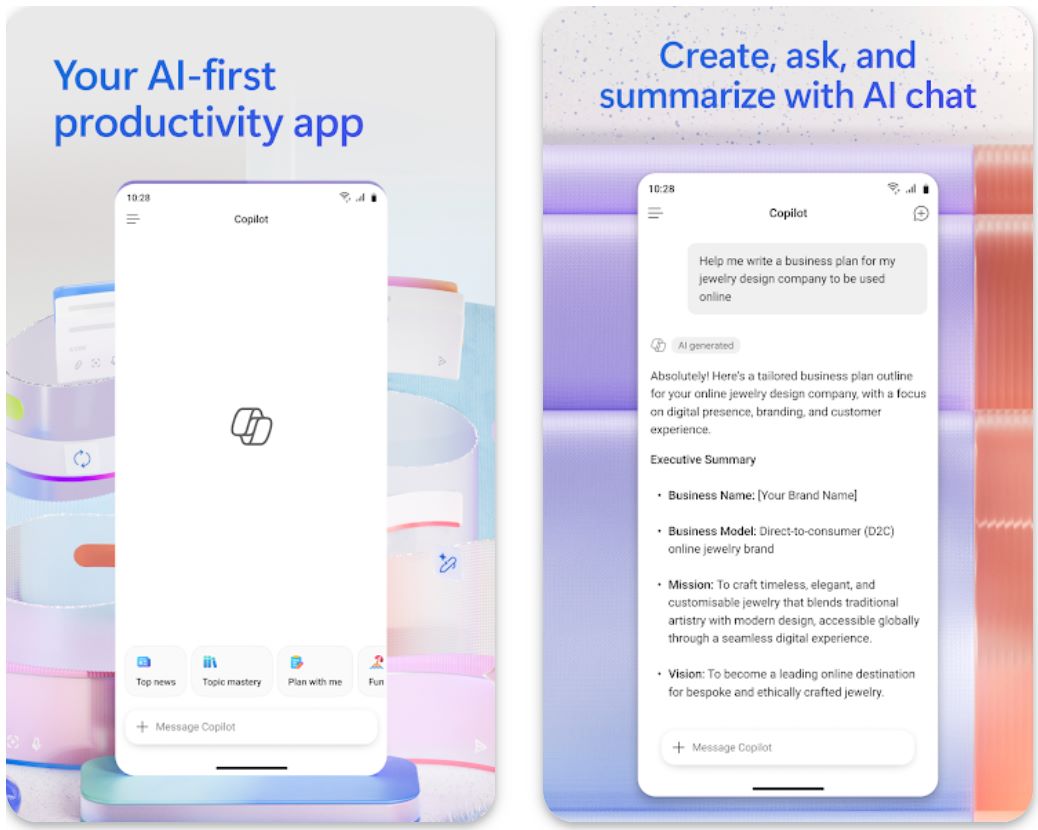
Key Features
Draft emails, documents, proposals, and reports using natural language prompts with context-aware suggestions.
Create meeting summaries, chat digests, email overviews, and document synopses automatically.
Generate trends, charts, formulas, and forecasts from natural language prompts in Excel.
Build professional PowerPoint slides from text prompts or existing document content.
Access in-app chat side-pane with knowledge of your open content for seamless assistance.
Transform chat responses into editable, shareable pages with live collaborative updates.
Build or deploy AI agents to automate workflows, integrate systems, and provide domain-specific knowledge.
Data governance, access control, prompt filtering, and comprehensive privacy settings built-in.
Upload documents to enrich context and request AI-generated images in responses (subject to limits).
Integrate live web search results when appropriate to complement organizational data.
Advantages
- Improves productivity by automating routine tasks like drafting, summarizing, and formatting
- Context-aware AI uses your organizational data to generate highly relevant responses
- Seamless integration into familiar Microsoft 365 apps reduces adoption friction
- Enterprise-grade security, compliance, and privacy safeguards (GDPR, data residency)
- Extensibility through Copilot Studio allows building custom agents for specific workflows
Limitations to Consider
- AI Hallucinations: May generate plausible but inaccurate or misleading content requiring fact-checking
- File Size Restrictions: Per-file and daily upload limits apply (licensed users ~10MB per file)
- Performance Constraints: Can lag with large datasets or complex prompts, especially in Excel
- No Autonomous Actions: All AI outputs require user review and approval before implementation
- Limited Memory: Does not retain conversational context across sessions beyond immediate interaction
- Over-Reliance Risk: Users may depend too heavily on AI output instead of critical thinking
- Regional Availability: Delayed rollout in some markets and languages
Download or Access Link
Getting Started Guide
Ensure you have a qualifying Microsoft 365 subscription and add the Copilot license. Administrators may need to assign user access and configure organizational policies.
Use the Microsoft 365 Copilot app (web, desktop, or mobile) to access chat, tools, and agents. Within supported Microsoft 365 applications (Word, Excel, Outlook, PowerPoint, Teams), Copilot appears via a side pane or embedded chat. Pin Copilot Chat in apps to make it persist across sessions.
Enter natural language prompts such as "Summarize last week's meeting," "Draft email to client," or "Analyze sales trends." Leverage suggested prompt templates provided in the interface. In chat, attach or upload files to provide additional context (subject to size limits).
Review, edit, reject, or accept generated content. For Copilot Pages, convert chat output into a live document you can continue editing or sharing with colleagues. Use agents for repeated workflows and integrate them as needed.
Administrators can set policies controlling who can use Copilot, data access scopes, and usage limits. Monitor usage analytics and agent performance via Copilot analytics tools to optimize organizational adoption.
Important Notes
- Copilot does not autonomously execute tasks without user oversight and approval
- Does not retain long-term memory beyond the active session or immediate context
- Some regions or languages may experience delayed feature availability
- Productivity impact varies by use case; effectiveness claims should be evaluated in your specific context
Frequently Asked Questions
You can access Copilot via the Microsoft 365 Copilot app (web, desktop, mobile) or through integrated chat side-panes within Microsoft 365 apps like Word, Excel, PowerPoint, Outlook, and Teams.
Copilot only accesses organizational data you have permission to view via Microsoft Graph. All prompts and data access respect your existing permissions and privacy boundaries.
No. Your prompts, responses, and data accessed through Microsoft Graph are not used to train the foundation large language models underlying Copilot.
Word, Excel, PowerPoint, Outlook, Teams, OneNote, and more are supported with side-pane/chat integration and shared contextual understanding across applications.
A limited Copilot Chat experience may be available with certain Microsoft 365 subscriptions and Entra accounts, but full Microsoft 365 Copilot capabilities require a paid add-on license.
Copilot Chat is a conversational AI interface grounded in web data or context from open documents. Full Microsoft 365 Copilot adds deeper integration with organizational content, priority capabilities (file upload, image generation), agents, reasoning enhancements, and in-app editing features.
Copilot is typically licensed per user (per-seat) as an add-on, often prepaid annually. Examples: Copilot Pro ~$20/user/month, Copilot for Microsoft 365 ~$30/user/month (pricing varies by market).
Yes, via agents built in Copilot Studio that can execute recurring tasks, access external systems, or incorporate domain logic—though human oversight is required for all automated actions.
Yes. Prompt length and complexity, model capacity, service availability, and file upload caps are constrained to ensure optimal service performance for all users.
Google Workspace AI (Gemini)
| Developer | Google (Google AI / DeepMind) |
| Supported Platforms |
|
| Language Support | Dozens of languages supported globally with regional variations |
| Pricing Model | Included in Google Workspace Business and Enterprise plans at no extra cost (as of January 2025). Personal users may access via Google AI / Google One plans |
What is Google Workspace AI (Gemini)?
Google Workspace AI (Gemini) is Google's integrated generative AI assistant embedded directly into the Google Workspace ecosystem. It helps users across Gmail, Docs, Sheets, Slides, Chat, Meet, Drive, and more with drafting, summarization, brainstorming, analytics, meeting notes, content creation, and context-aware suggestions.
Gemini's integration means AI assistance is available where users already work, reducing friction of switching to separate AI tools.
Detailed Overview
Google's evolution in Workspace AI started as Duet AI, which was rebranded and upgraded to Gemini for Google Workspace — giving users access to more capable AI models built into their productivity tools. With this change, AI features like drafting, summarizing, brainstorming, and creative generation are more deeply embedded in core apps.
In practice, a user in Gmail might ask Gemini to suggest replies or summarize long threads. In Docs, users can get outlines, edits, content suggestions or image inserts. In Chat, one can type @gemini to get summaries, highlight key points, and next steps. Over time, Google is introducing "Gems" (customized AI chatbots) that can specialize in tasks and are accessible inside Workspace apps.
- Seamless integration: AI is built directly into the apps users already use, reducing context switching
- Time savings: Summaries, drafts, autocomplete, brainstorming, and meeting note automation reduce routine effort
- Contextual awareness: Gemini can utilize document, email, chat, and calendar context within Workspace to tailor responses
- Enterprise data controls: Google ensures that organization's data is not used to train underlying models; admin control over data flows and policies
- Broad feature set: From content generation to analytics to meeting summarization and creative output
- Quality variability: As with all generative AI, outputs can contain errors, biases, or hallucinations
- Feature rollout disparities: Some features may be delayed in certain regions or Workspace tiers
- Requirements for license / plan: Some advanced Gemini features might still depend on particular Workspace tiers or Google AI subscription terms
- Privacy / security concerns: Though Google emphasizes control, integrating AI into sensitive content raises risk surfaces
- Context memory limits: The AI may struggle with long chains of context or cross-session memory
- Dependence risk: Overreliance may reduce critical thinking or oversight
Key Features
Suggest replies, generate email content, or summarize long email threads in Gmail
In Docs, get outlines, suggestions, rewriting, formatting help, and image generation inline
In Sheets, help with formulas, data trends, summarization of data, and charts
In Slides, assist with generating slides, layouts, images, and speaker notes
In Google Chat, use @gemini to get summaries, next steps, and flagged items
In Meet or via transcripts, auto-capture key points and action items
Deploy custom "Gems" bots specialized for tasks, accessible inline
PDF summarization when opened in Drive, summary cards with actions
Generate images, designs, and creative content in docs or slides
Gemini can draw on broader web content to supplement organizational data
Download or Access Link
How to Use Google Workspace AI (Gemini)
Confirm your Google Workspace plan is one that supports Gemini AI features (Business or Enterprise plans from January 2025 onward include AI features).
If your plan formerly required a Gemini add-on, those add-ons have been deprecated.
In the Admin Console, enable AI / Gemini features, manage user access, and define policies.
Ensure data access permissions align with compliance and security policies.
In Gmail, Docs, Sheets, Slides, and Chat, look for the Gemini icon or side panel ("Ask Gemini") to invoke AI assistance.
In Chat, type @gemini to trigger summarization or key insight features.
Use natural language prompts: e.g. "Summarize this email thread," "Generate an outline for a blog post from this doc," "Suggest formulas for this data."
In Docs or Sheets, highlight or select content to provide context for Gemini.
For custom workflow tasks, use Gems (once available) to create reusable assistants.
Always review AI-generated content for accuracy, tone, and contextual appropriateness.
Make edits or refine prompts for improved results.
Create and deploy Gems tailored to your domain (e.g. marketing copy, financial modeling).
Combine multiple prompt steps: e.g. summarization → action list → draft.
Use file or PDF summarization features (e.g. summary cards) where available.
Important Notes
- Some AI features may roll out gradually and not be available in all regions or for all users initially
- Certain advanced models or capabilities (e.g. very large context windows, reasoning) may be restricted or gated
- Data privacy concerns: although Google asserts organization data is not used to train base models, integration with content increases risk surfaces
- The AI's contextual memory is limited; long-term cross-session memory might not persist
- Overuse may cause user dependency and reduced human oversight
- Custom Gems and advanced features may require user understanding of prompt design and AI behavior
- Some advanced features (e.g. PDF summarization) may only support certain languages initially
Frequently Asked Questions
No—since January 2025, many premium AI / Gemini features are included in base Business and Enterprise Workspace plans.
Gmail, Docs, Sheets, Slides, Chat, Meet, Drive (for document summarization) support Gemini integration.
Gemini respects permissions in Google Workspace: it can access content you have permission to view, and admin controls help restrict data access.
Gems are customizable AI assistants (bots) built on top of Gemini that specialize in domain tasks and can be embedded into Workspace apps.
Yes—Google has introduced PDF summarization (summary cards) when opening PDFs in Drive, offering condensed summaries and suggestions.
No—Google states that content from customers is not used to train their underlying models.
You can ask for summaries, rewrite suggestions, outlines, brainstorming, data insights, formulas, image creation, meeting notes, and more.
Your administrator may not have enabled them, or they may not yet be rolled out to your region. Contact your workspace admin.
Yes—there are model capacity constraints, prompt size limits, region-based feature rollouts, and memory/context limits.
Yes—via Google AI / Google One plans, though the integration into Workspace apps will depend on plan and eligibility.
Slack GPT (AI trong Slack)
| Developer | Slack Technologies (Salesforce) in collaboration with AI model partners |
| Supported Platforms |
|
| Language Support | Multiple UI languages supported; AI features respect workspace language preferences globally |
| Pricing Model | Available on paid Slack plans with AI add-on at approximately $10/user/month |
What is Slack GPT?
Slack GPT (also known as Slack AI) is Slack's native generative AI assistant embedded directly into the Slack platform. It delivers powerful features like conversation summaries, smart search, channel recaps, thread summaries, and writing assistance—all without leaving Slack. The goal is to save time, reduce information overload, and provide instant insights and drafting support within your existing workflow.
Slack GPT also integrates seamlessly with workflows, allowing users and admins to embed AI steps in workflow builders or connect with leading LLMs like OpenAI and Anthropic for enhanced automation.
How Slack GPT Works
Slack began rolling out "Slack AI" features designed to leverage your team's conversational and file history to deliver context-aware value. The Slack GPT concept—announced by Salesforce—positions Slack as a conversational AI platform where AI is natively integrated into the user experience, securely accessing trusted customer data (such as Salesforce's Data Cloud and Customer 360) in governed, compliant ways.
Slack GPT enables organizations to tap into internal knowledge bases (past messages, files, decisions) and external AI models in a controlled environment. It also powers AI-driven workflows, triggering content generation or summarization directly within workflow builder steps.
Slack's AI features use generative models to streamline team communication. Built into the Slack interface, the AI can summarize channels and huddles, allowing you to catch up on discussions with a single click. For example, you can ask the AI to join a voice call and produce instant notes or action items afterward.
Slack's AI can also adjust message tone, translate conversations on demand, and auto-generate replies. In essence, Slack's AI acts like a digital colleague—saving time by distilling long threads into concise recaps and handling routine writing tasks efficiently.
Key Advantages
- Time savings & reduced context switching: Get summaries, recaps, or drafts within Slack instead of switching to another tool
- Context-aware responses: AI leverages Slack conversation history and files to ground its suggestions in real data
- Seamless integration: AI is embedded in the same interface users already use (search, threads, workflows)
- Configurable & controlled deployment: Admins can manage who has access to AI features for security and compliance
- Support for multiple LLMs: Slack GPT allows integration with different models (OpenAI, Anthropic, custom) inside Slack workflows
Potential Challenges
- Potential for inaccuracies (hallucinations): As with all generative AI, Slack GPT can produce incorrect or misleading information
- Rollout & feature parity gaps: Not all features are available everywhere or immediately; some AI features lag by region or plan
- Dependency & overreliance: Users may trust AI outputs too readily without verification
- Data & privacy concerns: Tight integration with internal data raises risk; careful governance is needed. Slack states that customer data is not used to train underlying models and stays within Slack's secure infrastructure
- Context limits: Deep context across many threads or over time may exceed model memory or prompt limits
- Cost: For smaller teams, the $10/user/month AI add-on might be a barrier
Core Features
Ask questions in natural language and get concise answers drawn from messages and files you already have access to.
Generate summaries of long conversation threads to catch up quickly without reading every message.
Produce key highlights of a channel over a period (e.g., past 7 days) or a custom date range.
AI can help compose or refine messages in Slack, adjusting tone and improving clarity.
AI steps can be embedded into Slack workflows for automation (e.g., generate summary, send draft).
Slack GPT allows using external AI models (OpenAI, Anthropic, custom) in Slack integrations.
Admins can enable/disable AI features for specific people or groups, ensuring secure deployment.
Download or Access Link
Getting Started with Slack GPT
Slack AI/GPT features require a paid Slack plan and the proper tier or add-on. Workspace admins must enable AI features in the Slack Admin console (Roles & Permissions → Feature Access → AI).
In the Slack settings (Admin), toggle AI features on or off for groups or individuals. Once enabled, users will see AI options (summaries, recaps, AI-powered search) in their Slack interface.
Use the Slack search bar or AI search prompt: ask questions in natural language (e.g., "When was the last update on project X?"). The AI will return a concise answer citing relevant messages/files you have access to.
In a thread or channel, choose "Summarize" or "Recap" (or similar UI action). The AI will return a distilled version of key points, mentions, and decisions.
In message input, use AI suggestions or request assistance in drafting or editing text. Review and edit the AI's proposed content before sending.
In Slack's Workflow Builder, add steps that call AI functions (e.g., "summarize this thread," "generate summary report"). Use triggers (e.g., new message, new file) to invoke AI steps automatically.
Admins monitor usage and performance of AI features. Adjust access or disable features as needed for security or compliance.
Important Notes
- AI features may not be available instantly everywhere; gradual rollout and phased deployment is common
- Some external AI integrations or LLMs might impose rate limits or usage caps
- The AI memory/context window is limited. Very long or multi-thread contexts may be truncated
- Always review AI outputs—especially for sensitive or critical communication
Frequently Asked Questions
Slack GPT (or Slack AI) refers to Slack's native generative AI capabilities built into the platform: summary generation, AI search, drafting, recaps, and integration with workflows and external AI models.
No. The AI features are native to Slack once enabled. External "ChatGPT in Slack" apps also exist, but Slack GPT is built-in.
Paid Slack plan users where admins have enabled AI features. Access is managed via Workspace settings (Role & Permissions).
Slack's paid plans plus the AI add-on ($10/user/month) include these generative capabilities.
No. Slack states customer data is not used to train LLMs. AI queries operate within Slack's infrastructure.
Yes. Slack GPT supports integration with third-party LLMs (OpenAI, Anthropic, custom) in workflows.
You can ask for summaries, recaps, drafting assistance, Q&A about content in Slack, or embed AI operations in workflows.
Yes. AI features may have usage caps, prompt size limits, or rate limits, depending on model/provider.
Check with your Slack workspace admin: features may not yet be enabled or rolled out to your region.
Notion AI
| Developer | Notion Labs Inc. |
| Supported Platforms |
|
| Language Support | Multi-language interface support. AI features work globally with English fully supported; translation and rewriting available across supported languages |
| Pricing Model | Limited free trial (20 AI responses). Full AI access requires Business or Enterprise plan subscription |
What is Notion AI?
Notion AI is an artificial intelligence assistant integrated directly into the Notion workspace. It enhances Notion's core functionality—notes, databases, documents, and wikis—by providing generative AI tools for summarization, content drafting, meeting transcription, Q&A within your workspace, and contextual assistance. Designed to eliminate repetitive tasks and surface insights from existing content, Notion AI helps users focus on high-value work.
How Notion AI Works
Notion AI leverages content already stored in your Notion workspace (pages, databases, notes) combined with advanced generative AI technology. Users can invoke AI actions through commands or the AI sidebar to summarize lengthy pages, generate drafts, extract action items, answer workspace-specific questions, or create structured content from prompts.
Recent enhancements include AI Meeting Notes (transcription and summarization of conversations), Research Mode (AI-powered reports combining workspace and web sources), and Enterprise Search with AI Connectors (search across integrated tools like Slack, Google Workspace, and GitHub).
Users can also choose between Notion's internal AI models or external options like GPT-4.1 or Claude 3.7 for greater flexibility, though external models typically do not access your private workspace data.
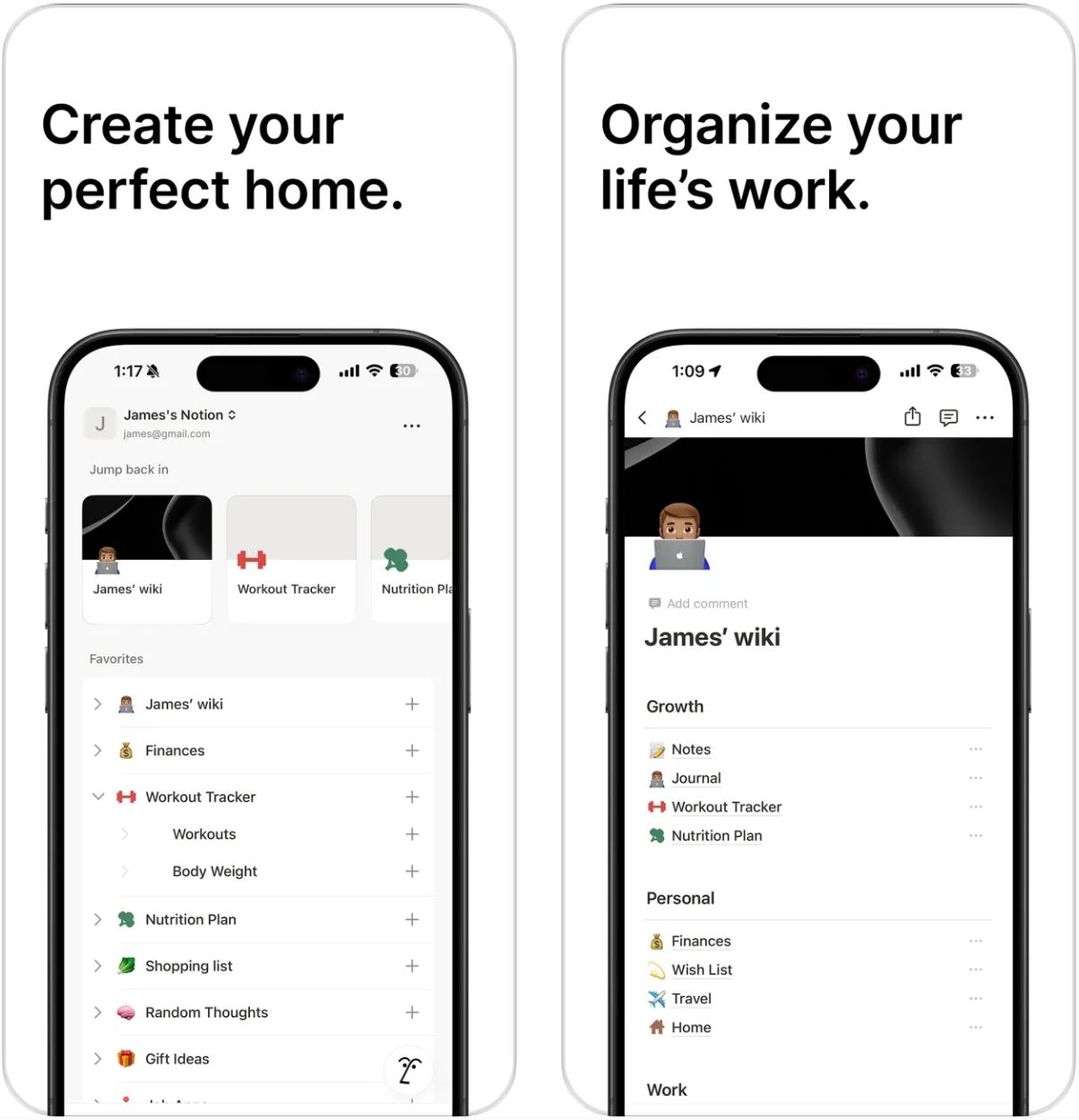
Key Features
Create drafts, blog posts, proposals, and emails instantly with AI-powered writing assistance.
Condense long pages, meeting notes, and documents into concise key points automatically.
Transcribe audio conversations, generate summaries, and extract action items effortlessly.
Combine workspace content with web sources to produce comprehensive reports and strategic documents.
Search across connected tools (Slack, Google Workspace, GitHub) using natural language queries.
Translate text between languages or adjust tone and style of existing content.
Generate, clean, or populate database content using AI prompts for faster data management.
Summarize or answer questions about uploaded PDFs and documents within your workspace.
Advantages
- Deep integration: AI built directly into your workspace—no need to switch between external tools
- Context-aware outputs: Results grounded in your existing workspace content for maximum relevance
- Significant time savings: Automated summaries, drafts, action items, and content generation accelerate workflows
- Advanced capabilities: Meeting transcripts, multi-tool search, and research mode expand Notion's functionality
- Privacy-focused: Customer data is not used to train base models; AI subprocessors are contractually restricted
Limitations & Challenges
- Limited free access: AI features disabled after trial unless you upgrade to paid plans
- Higher pricing: AI access consolidated into Business and Enterprise tiers, increasing costs
- Potential AI errors: Like all generative AI, may produce incorrect or misleading content
- Context limitations: Very large pages may exceed AI processing capacity
- Over-reliance risk: Users may accept AI output without sufficient manual review
- Gradual rollout: Advanced features (connectors, enterprise search) not immediately available to all workspaces
Download or Access
Getting Started with Notion AI
New users on Free or Plus plans receive a limited trial (typically 20 AI responses). For full AI capabilities, upgrade to Business or Enterprise plan.
Navigate to workspace settings or billing to enable Notion AI. Check availability of new features (AI Meeting Notes, Research Mode, Connectors) as some roll out gradually.
Use AI commands like /ai summarize or /ai write within any Notion page. Select text and ask AI questions, or open the AI sidebar for broader queries.
Start a meeting recording or import transcripts. Use AI Meeting Notes to transcribe conversations, highlight summaries, and extract actionable tasks automatically.
Invoke Research Mode to build comprehensive documents combining workspace content and web sources. Use prompts like "Generate market trends summary" or "Create competitor analysis."
Enable AI connectors (Slack, Google Workspace, GitHub) in settings to allow natural language queries across integrated systems using enterprise search.
Always review AI-generated output for accuracy, tone, and context. Use editing features (rewrite, translate, adjust) to refine results before finalizing.
Workspace admins can monitor AI usage and control rollout settings. Manage which users have access to advanced AI features like meeting notes and connectors.
Important Notes
- AI usage is subject to fair use policies and internal quotas, even on paid plans
- External AI models (GPT-4.1, Claude 3.7) do not automatically access workspace data for privacy protection
- Large documents or deep context may exceed AI processing capacity—chunk content or focus prompts for better results
- Notion restructured AI access in 2025, bundling features into higher-tier plans instead of standalone add-ons
Frequently Asked Questions
No. Users on Free or Plus plans receive a limited AI trial (typically 20 responses). After the trial, you must upgrade to Business or Enterprise plans to continue using AI features.
As of 2025, the Business plan (which includes full AI access) costs approximately USD $20 per user per month when billed annually. It includes private teamspaces, 90-day version history, advanced analytics, SAML SSO, and more.
Yes. If you downgrade to a plan without AI support, AI features will no longer be accessible after your current billing cycle ends.
Yes. With AI Meeting Notes, Notion can transcribe conversations and automatically create summaries and action items from your meetings.
By default, no. Notion states that your data is not used to train underlying AI models. AI subprocessors are contractually prohibited from training on customer data unless you explicitly opt in.
Research Mode allows Notion AI to gather information from both your workspace and web sources to generate comprehensive reports, briefs, or strategic documents automatically.
Yes. You can choose external models (GPT-4.1, Claude 3.7) for certain tasks. However, these models generally will not have access to your workspace data for privacy reasons.
In 2025, Notion reorganized AI access by discontinuing standalone AI add-ons and integrating full AI features into Business and Enterprise tiers. This effectively raised base prices for many users but simplified the pricing structure.
This may be due to phased rollout. Check for updates in your workspace settings or contact Notion support—many features are still being gradually enabled across workspaces.
While Business and Enterprise plans offer "unlimited" access in principle, usage is subject to internal quotas and fair use policies to maintain system performance.
No. On Business and Enterprise plans, AI is fully integrated and cannot be separately disabled to reduce plan costs. You would need to downgrade your entire plan to a lower tier.
OpenAI ChatGPT (GPT-4o)
| Developer | OpenAI |
| Model | GPT-4o (GPT-4 omni) |
| Supported Platforms |
|
| Language Support | Multilingual model supporting many languages beyond English |
| Pricing Model | Free tier with usage limits. ChatGPT Plus ($20/month) offers unlimited access and advanced features |
| Knowledge Cutoff | October 2023 |
What is GPT-4o?
GPT-4o (where "o" stands for "omni") is OpenAI's advanced multimodal AI model that processes and generates text, audio, and images within a single unified architecture. Integrated into ChatGPT, GPT-4o delivers faster, more natural conversational experiences with voice interaction, image understanding, and real-time responses.
As an evolution of GPT-4 Turbo, GPT-4o offers significant improvements in speed, cost efficiency, and multimodal capabilities, making it one of the most versatile AI assistants available today.
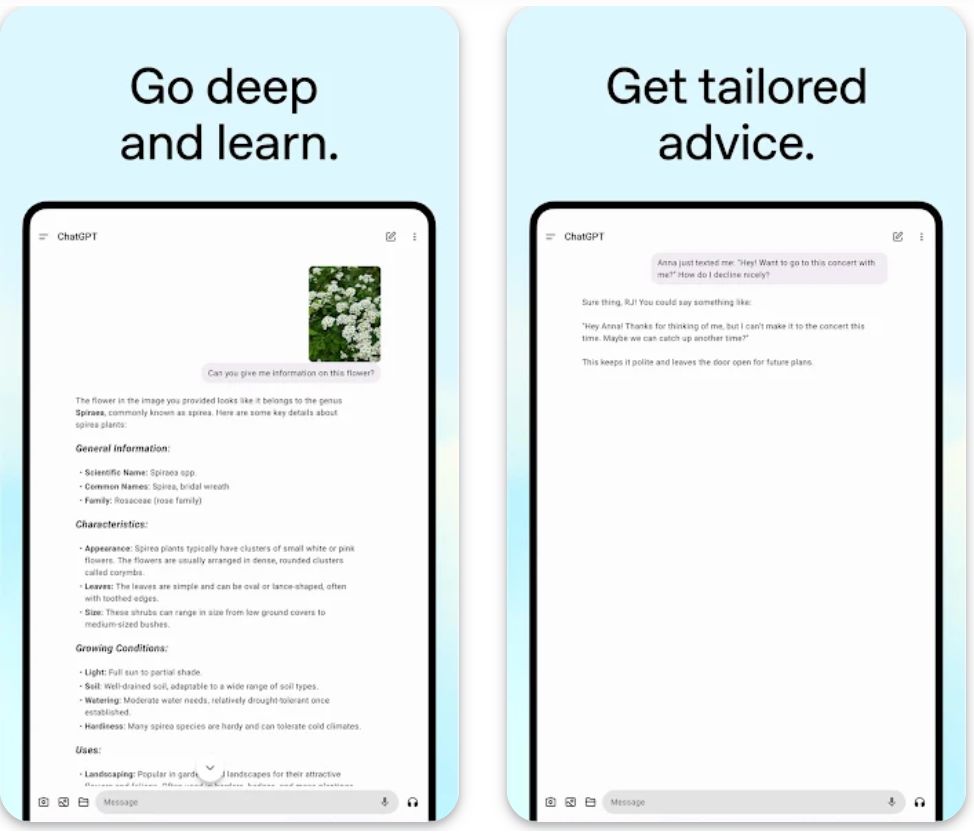
Technical Capabilities
GPT-4o is built as a unified model that handles text, audio, and image input/output seamlessly. The model responds to audio inputs with remarkably low latency—averaging just 320 milliseconds—and features enhanced multilingual performance and vision reasoning capabilities. It also supports native image generation within ChatGPT conversations.
Compared to previous GPT-4 models, GPT-4o delivers 2× faster performance and 50% lower costs, while maintaining superior quality across all modalities.
Key Advantages
Process and respond to images, audio, and text in a single integrated architecture
Audio responses average ~320ms, enabling natural real-time conversations
2× faster and 50% cheaper than GPT-4 Turbo while maintaining quality
Improved performance and efficiency across dozens of languages
Strong image understanding and reasoning capabilities
Create images grounded in prompt context directly within conversations
Limitations to Consider
- Knowledge cutoff: Training data ends at October 2023, limiting awareness of recent events
- Hallucination risk: May occasionally generate incorrect or fabricated information
- Context constraints: Very lengthy conversations or documents may challenge coherence
- Staged rollout: Some audio and video features may be in preview or limited availability
- Resource intensive: Multimodal processing requires higher computational resources
- Availability changes: Temporarily removed during GPT-5 rollout, later reinstated for paid users
Complete Feature Set
- Text generation & reasoning: Summaries, Q&A, content creation, code generation, logic tasks
- Audio/voice interaction: Conversational voice mode with fast latency for natural dialogue
- Vision & image understanding: Interpret and reason about user-supplied images
- Image generation: Produce images from prompts with precise rendering and context alignment
- Multilingual performance: Improved handling across many languages
- Low-latency responses: Fast reaction times, especially in voice mode (~320ms average)
- API access & variants: GPT-4o and GPT-4o Mini available via OpenAI API
- Structured output: JSON schema support and function calling for integrations
Access ChatGPT with GPT-4o
How to Use GPT-4o
Sign up or log into your ChatGPT account via OpenAI's website. Existing users can access GPT-4o immediately.
In the ChatGPT interface, choose GPT-4o as your active model. Paid subscribers receive higher usage limits and priority access.
Activate voice mode to speak with ChatGPT and receive audio responses. Upload images or take photos for visual analysis and interpretation.
Enter natural language queries or commands (e.g., "Summarize this article," "Translate this image text," "Write me code"). For structured tasks, specify output formats like JSON or bullet lists.
Evaluate generated output, correct any errors, and refine results with follow-up prompts or clarifications for improved accuracy.
Access GPT-4o via OpenAI API for text and vision modes. Use GPT-4o Mini for cost-efficient applications. Deploy through Azure OpenAI in supported regions.
Important Notes
- GPT-4o was temporarily removed during GPT-5 launch but reinstated for paid users due to demand—verify current availability in your region
- Usage and pricing depend on token input/output; cost structures vary between API usage and ChatGPT subscription tiers
- The model's knowledge is static up to October 2023—it cannot reliably reason about events after that date
- Always validate critical outputs and guard against hallucinations or bias
- Multimodal capabilities add richness but also complexity—context limits and interpretive errors remain possible
Frequently Asked Questions
The "o" stands for "omni," reflecting its unified multimodal design that seamlessly handles text, audio, and vision in a single architecture.
Yes, GPT-4o is available to free ChatGPT users with limited usage. Paid tiers like ChatGPT Plus provide expanded limits and access to advanced features.
ChatGPT Plus costs $20/month and includes unlimited access to GPT-4o, voice and video features, higher usage limits, and priority access during peak times.
GPT-4o Mini is a lighter, cost-efficient variant of GPT-4o, optimized for text and vision tasks with significantly lower operational costs while maintaining strong performance.
Yes, GPT-4o supports native image generation, allowing you to request visual content that's grounded in your prompt context and conversation history.
Yes, GPT-4o supports voice mode with ultra-low latency audio input and output (averaging ~320ms), enabling natural, real-time conversational experiences.
GPT-4o API pricing is structured by input/output tokens and model version. Specific rates vary by plan and usage volume—check OpenAI's pricing page for current details.
Yes, GPT-4o's training data is current up to October 2023. The model may not have accurate information about events or developments after that date.
GPT-4o was temporarily removed during the rollout of GPT-5. However, due to strong user demand and feedback, OpenAI reinstated it for paid subscribers.
OpenAI has implemented safety filters, extensive red teaming, and training mitigations to reduce misuse, hallucinations, and harmful outputs. Detailed safety evaluations are published in system cards.
Yes, developers can embed GPT-4o text and vision modalities into applications through the OpenAI API or Azure OpenAI Service in supported regions.
Otter.ai
| Developer | Otter.ai, Inc. (formerly AISense) — Mountain View, California, USA |
| Supported Platforms |
|
| Language Support | English, Spanish, and French — available globally with regional restrictions |
| Pricing Model | Free Basic plan with limited minutes. Paid tiers: Pro, Business, and Enterprise unlock higher limits and advanced features |
What is Otter.ai?
Otter.ai is an AI-powered transcription and meeting assistant that converts live conversations and recorded audio into accurate, searchable text. It automatically generates real-time transcripts, identifies speakers, extracts summaries and action items, and creates shareable meeting notes. Widely used for business meetings, lectures, interviews, and webinars, Otter.ai helps teams reduce manual note-taking and boost meeting productivity.
How Otter.ai Works
Otter.ai captures audio from live meetings or uploaded files, processes speech-to-text in real time, aligns text with timestamps and speaker labels, then applies AI to extract summaries, highlights, insights, and action items.
The platform integrates seamlessly with popular meeting tools like Zoom, Google Meet, and Microsoft Teams. Simply invite Otter to join your meeting, and it will transcribe conversations as they happen.
In 2025, Otter introduced advanced AI agents including a voice-activated Meeting Agent that answers questions about past meetings, and specialized Sales/SDR agents that assist during live calls.
When Otter joins a call, it delivers a live transcript with high accuracy and generates a concise summary afterward. The AI Meeting Agent automatically highlights key points and assigns tasks, acting like an executive assistant that never misses details.
Teams using Otter report saving approximately one-third of their time by transforming every voice conversation into searchable notes and actionable follow-ups.
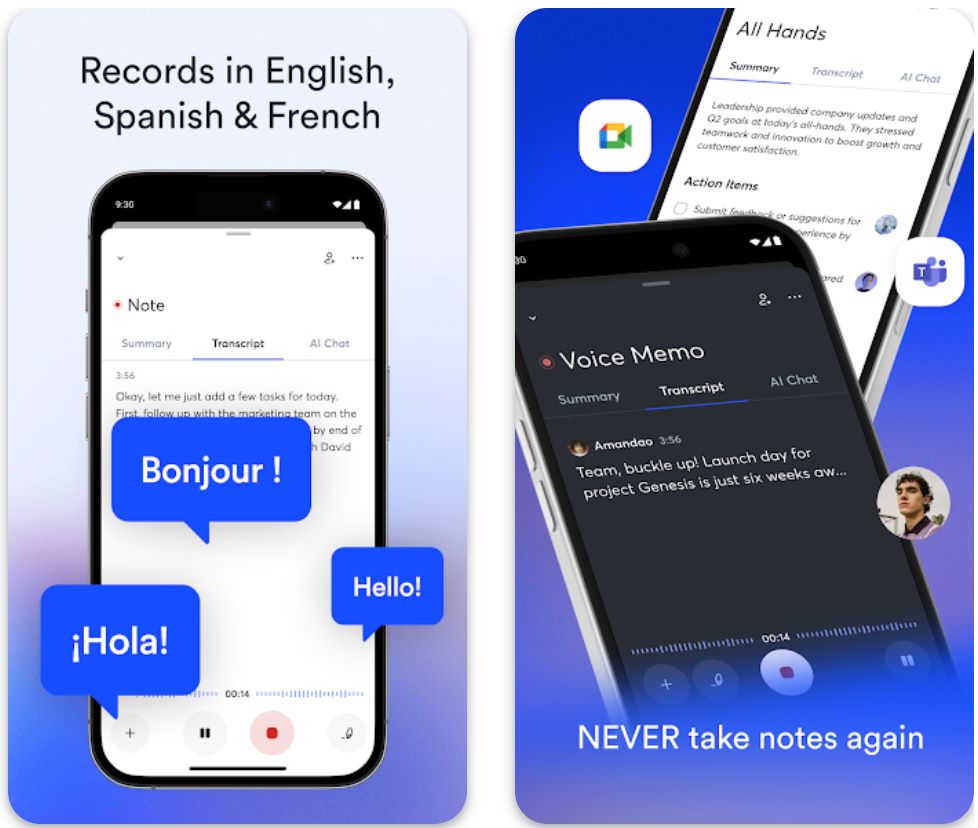
Key Advantages
- Time-saving automation: Automatically produces meeting transcripts, summaries, and action items
- Searchable archives: Transcripts and notes are fully searchable and easily shared with colleagues
- Speaker identification: Distinguishes speakers and labels them for easier review
- Seamless integrations: Works with Zoom, Google Meet, Teams; syncs with calendars; imports audio/video files
- AI agent capabilities: New Meeting Agent responds via voice, drafts follow-ups, queries past meetings
- Cross-platform access: Available on web, iOS, and Android
Limitations & Challenges
- Limited language support: Only supports English, Spanish, and French — not suitable for all locales
- Transcription accuracy: Noisy environments, accents, and overlapping speech may require manual correction
- Usage restrictions: Free and lower tiers impose strict limits on monthly minutes and max conversation length
- Scaling costs: Business and Enterprise tiers increase costs significantly as team usage grows
- Privacy concerns: Recording meetings raises legal and ethical issues; recent lawsuit alleges recordings without full participant consent
- Feature rollout: Some new AI agent features are being deployed gradually and may not be active on all accounts
Core Features
Capture audio live and display text as speakers talk with high accuracy.
Generate concise summaries, key points, quotes, and actionable insights automatically.
Automatically identify and tag tasks or follow-ups from meeting conversations.
Identify who says what with editable speaker labels for accurate attribution.
Transcribe pre-recorded content including meetings, podcasts, and lectures.
Audio and text alignment with speed control and precise timecodes.
Adapt speech recognition to specialized terms and industry jargon.
Share transcripts, edit together, and export to multiple formats.
Voice-activated assistant that queries past meetings, drafts emails, and supports sales teams.
Automatically join scheduled meetings via Zoom, Google Meet, and Microsoft Teams.
Download or Access Link
Getting Started Guide
Sign up via the Otter.ai website or mobile app (iOS/Android). Choose between free or paid plans based on your transcription needs and usage limits.
Link Otter to your calendar so it can automatically join scheduled meetings. Authorize access to Zoom, Google Meet, or Microsoft Teams for seamless integration.
For online meetings, invite Otter or the Otter assistant to join — it will transcribe in real time. For in-person recordings, open the Otter app and record directly for live transcription.
Leverage Otter's AI chat or Meeting Agent to ask questions about the meeting ("What is the next step?") or generate follow-up drafts. Note: Agent features may require certain plan levels.
After transcription, review text, correct speaker labels, highlight important sections, and assign action items. Export transcripts in TXT, PDF, DOCX, or SRT formats and share via links.
Check your monthly transcription minutes and quotas regularly. If approaching your limit, consider upgrading your plan or managing usage more efficiently.
Important Notes
- Audio quality matters: Background noise, accents, and overlapping speech can significantly degrade transcription accuracy
- Resource consumption: Advanced AI agent features and insights may consume additional computational resources or quota
- Plan upgrades: Consider upgrading if you frequently hit monthly limits or need longer conversation durations
Frequently Asked Questions
Yes, Otter offers a Basic free plan with limited monthly transcription minutes and features. This plan includes 300 minutes per month and a maximum of 30 minutes per conversation.
- Pro: $8.33/month per user (billed annually) or ~$16.99 monthly — includes 1,200 minutes/month, 90 minutes max per session, advanced features
- Business: ~$20/user/month (annual) or ~$30/month — includes 6,000 minutes/month, 4-hour max per session, team features and admin controls
- Enterprise: Custom pricing with advanced security, dedicated support, and full agent features
Currently, Otter supports transcription in English, Spanish, and French. Support for additional languages may be added in future updates.
Yes — when integrated with your calendar, Otter can automatically join scheduled Zoom, Google Meet, or Microsoft Teams meetings to transcribe conversations in real time.
The Meeting Agent is a voice-activated AI assistant that can listen to meetings, answer questions about meeting content, draft follow-up emails, and take actions based on conversation context. This feature is being rolled out gradually.
Otter's official policy states they do not use customer data to train base models without permission. However, privacy and data use remain important considerations — review their privacy policy for complete details.
Yes, transcripts can be exported to multiple file formats including TXT, PDF, DOCX, and SRT for use in other applications or archiving purposes.
You cannot transcribe further until the next billing cycle begins or until you upgrade to a higher plan with more minutes. Plan your usage accordingly to avoid interruptions.
Otter uses encryption and security measures to protect data. However, users must ensure proper consent for recordings to comply with legal requirements. A recent lawsuit raises awareness of potential legal and ethical risks regarding recording without full participant consent.
Fireflies.ai
| Developer | Fireflies (Co-founders: Krish Ramineni, CEO & Sam Udotong, CTO) — team spans 20 countries and 47 cities |
| Supported Platforms |
|
| Language Support | 100+ languages supported for transcription globally |
| Pricing Model | Free tier with limited access. Paid plans: Pro, Business, and Enterprise unlock advanced features, higher transcription capacity, integrations, analytics, and enterprise security |
What is Fireflies.ai?
Fireflies.ai is an AI-powered meeting assistant that automatically records, transcribes, and summarizes audio and video calls in real time. It joins your meetings to capture every word, generates detailed bullet-point notes, extracts action items, and enables keyword search across past conversations.
With support for over 100 languages and automatic speaker identification, Fireflies helps teams maintain a "perfect memory" of every discussion. It seamlessly integrates with CRM and project management tools — for example, automatically updating Salesforce with key insights and next steps after sales calls.
How Fireflies.ai Works
When a meeting starts or is scheduled, Fireflies joins as a bot or via platform integration to listen to the audio/video feed. It transcribes spoken words with timestamps, identifies speakers, and processes the transcript using AI to generate summaries, detect topics, extract action items, and surface insights like sentiment analysis and talk-time metrics.
The platform offers a robust API that allows uploading audio/video files, fetching transcripts or structured insights, managing teams and users, and performing CRUD operations on meeting data using token-based authentication. Recent additions include "Talk to Fireflies" — a voice-activated assistant during meetings — and real-time web search integration powered by Perplexity.
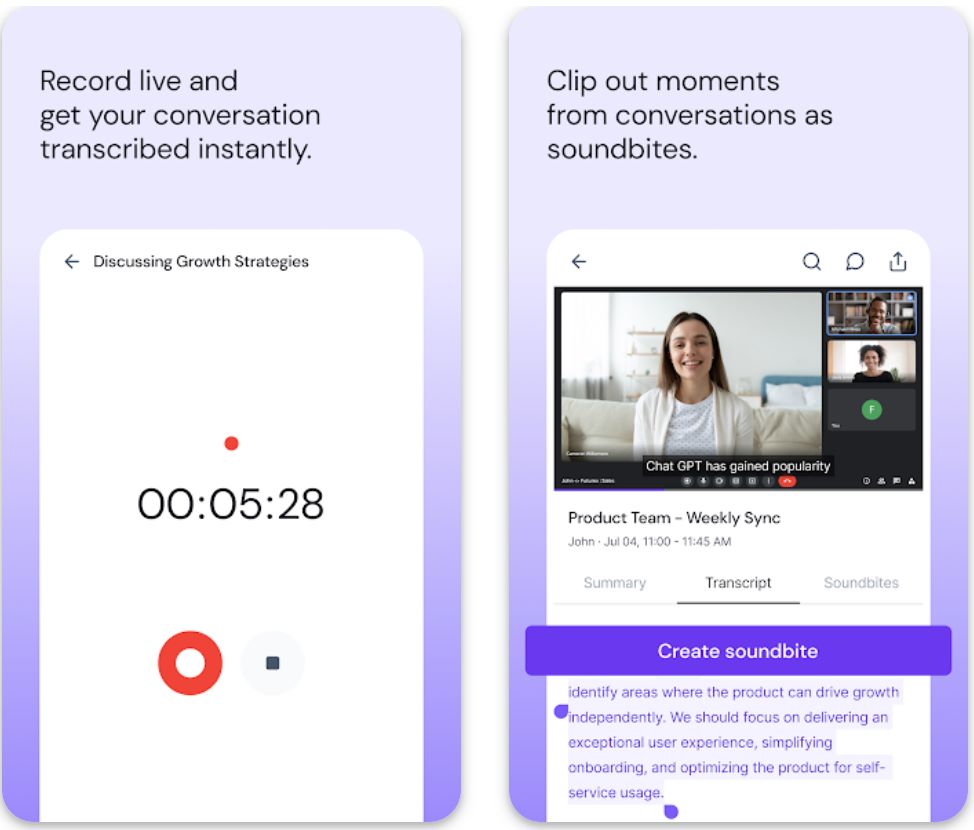
Key Advantages
- Time-saving automation: Eliminates manual note-taking with automatic transcription, summaries, and action-item extraction
- Searchable archive: Fully searchable transcripts with filtering by topics, keywords, or key moments
- Extensive integrations: Works seamlessly with Zoom, Google Meet, Teams, Slack, CRMs, and project management tools
- Multi-language support: Transcribes conversations in 100+ languages with high accuracy
- Developer-friendly API: GraphQL API enables custom integrations and embedding transcription intelligence in your systems
- Enterprise security: SSO, HIPAA compliance, private storage, and custom data retention in enterprise plans
- Voice-activated assistant: "Talk to Fireflies" enables real-time questions and answers during meetings
Limitations & Challenges
- Accuracy variability: Transcription quality may decrease in noisy environments, with strong accents, or overlapping speech — manual correction sometimes needed
- Free tier restrictions: Limited storage, transcription minutes, and missing advanced features in the free plan
- Usage-based costs: Some plans use AI "credits" or have usage limits that may incur additional charges
- Feature availability: Advanced features like "Talk to Fireflies" may not be immediately available for all users or plans
- Requires human oversight: AI-generated summaries and insights need review to ensure accuracy and context
- Resource demands: Processing large meetings or multiple concurrent sessions can be resource-intensive
Core Features
Real-time transcription during meetings on all supported conferencing platforms with timestamp alignment.
Transcribe past recordings from common formats (MP3, MP4, WAV) for archival and analysis.
Generate concise meeting summaries, key moments, quotes, and action items automatically.
Automatic speaker labeling with timestamps and manual editing capabilities for accuracy.
Global search across all meetings with filtering by topics, keywords, or speakers.
AI automatically detects tasks, follow-ups, and decisions discussed during meetings.
Connect with Slack, CRMs (Salesforce, HubSpot), Asana, Notion, Zapier, and 40+ tools.
Talk time metrics, sentiment analysis, topic trends, and team-level performance insights.
"Talk to Fireflies" enables asking questions during meetings and retrieving contextual insights in real time.
Record screen and audio simultaneously in Business and Enterprise plans.
GraphQL API with token authentication, webhooks, and custom integration capabilities.
Download or Access Link
Getting Started Guide
Visit Fireflies.ai and register for a free account or select a paid plan that fits your needs.
Link your Zoom, Google Meet, Microsoft Teams, or other conferencing tools so Fireflies can join meetings automatically. Connect your calendar to enable auto-join for scheduled meetings.
Add the Fireflies bot to upcoming meetings or enable auto-join. The bot will record and transcribe conversations in real time during the meeting.
After the meeting, open the transcript to review, edit, and label speaker segments. Use AI summary and highlights to get a quick overview. Extract action items, questions, and follow-up tasks.
Use global search across past meetings. Filter transcripts by keyword, topic, or speaker. Organize meetings into channels or folders for easy access.
In supported plans, activate "Talk to Fireflies" during meetings to ask questions about what was said and receive instant contextual answers.
Export transcripts in DOCX, PDF, or SRT formats. Clip soundbites or share key moments. Route summaries or notes into other tools like Slack, Notion, or CRMs.
Generate your API key in Fireflies settings. Use GraphQL endpoints to upload meeting audio, fetch transcripts and summaries, and integrate meeting data into your custom applications. Configure webhooks or scheduled queries for automation.
Important Notes
- Transcription accuracy: Results depend on audio quality, speaker clarity, background noise, and accents — manual correction may be needed for optimal results
- API constraints: API usage is subject to rate limits, token authentication requirements, and query constraints
- Enterprise security: Enterprise plans offer HIPAA compliance, private storage, SSO, and custom retention policies for regulated industries
- Usage costs: Some plans use AI credits that may be consumed with heavy use — monitor your usage to avoid unexpected charges
- Human oversight required: AI summaries and detections may miss nuance or context — always review critical information
Frequently Asked Questions
Yes, Fireflies offers a Free tier with limited transcription minutes, basic features, and restricted integrations. It's ideal for testing the platform or light personal use.
- Pro: ~$18/seat/month (billed annually) or ~$10 in some regions
- Business: ~$29/seat/month (billed annually) or ~$19 for annual billing
- Enterprise: ~$39/seat/month (billed annually) with advanced add-ons including compliance, SSO, and private storage
Fireflies integrates with Zoom, Google Meet, Microsoft Teams, Webex, GoToMeeting, Skype, RingCentral, and other platforms via native integrations or bot access.
Yes — you can upload files in common formats (MP3, MP4, WAV, etc.) for transcription and analysis.
"Talk to Fireflies" is a voice-activated AI assistant that allows meeting participants to ask questions during meetings and receive contextual insights in real time.
Yes. Fireflies offers a GraphQL API that enables developers to upload audio, fetch transcripts, extract insights, and manage meeting data using token-based authentication.
Enterprise plans include SSO, HIPAA compliance, private storage, and custom retention settings to meet regulatory requirements.
Fireflies typically achieves 90%+ accuracy, though real-world results depend on audio quality, accents, overlapping speech, and background noise. Manual review is recommended for critical content.
Yes. Transcripts and summaries can be exported to DOCX, PDF, SRT, and other formats for sharing and archival purposes.
You may hit usage caps, incur overage costs, or need to upgrade to a higher plan. Some plans use AI credits that are consumed with use — monitor your usage dashboard to avoid unexpected charges.
Canva Magic Studio
| Developer | Canva (founded by Melanie Perkins, Cliff Obrecht, and Cameron Adams) |
| Supported Platforms |
|
| Language Support | Multiple languages supported (AI features optimized for English) |
| Pricing Model | Free tier with limited features. Full access requires Canva Pro or Teams subscription |
What is Canva Magic Studio?
Canva Magic Studio is an AI-powered creative suite integrated directly into Canva's design platform. It consolidates generative AI tools for design, content creation, and media production into one unified workspace—eliminating the need to switch between multiple external applications.
Magic Studio enables users to generate complete designs, visuals, animations, videos, and copy using simple text prompts or existing media. Whether you're creating social media graphics, presentations, or marketing materials, the AI streamlines your workflow from initial concept to polished output.
For example, type a text prompt to instantly generate custom illustrations or background images, or input a paragraph and let Magic Write transform it into structured bullet points and headings—all without leaving the Canva editor.
How Magic Studio Works
Magic Studio represents Canva's consolidation of AI capabilities under a single, accessible framework. Rather than relying on separate plugins or third-party integrations, all AI features are embedded directly into the Canva editor interface.
When you create a new design or upload assets, you can invoke Magic Studio to generate layouts, transform content formats, or produce visual variations. The AI analyzes both visual and textual context to deliver intelligent design recommendations, media generation, and copywriting assistance.
With recent updates integrated into Canva's Visual Suite 2.0, Magic Studio now extends beyond traditional design—supporting spreadsheet workflows, generative data insights, and AI-assisted document creation for comprehensive creative and business applications.
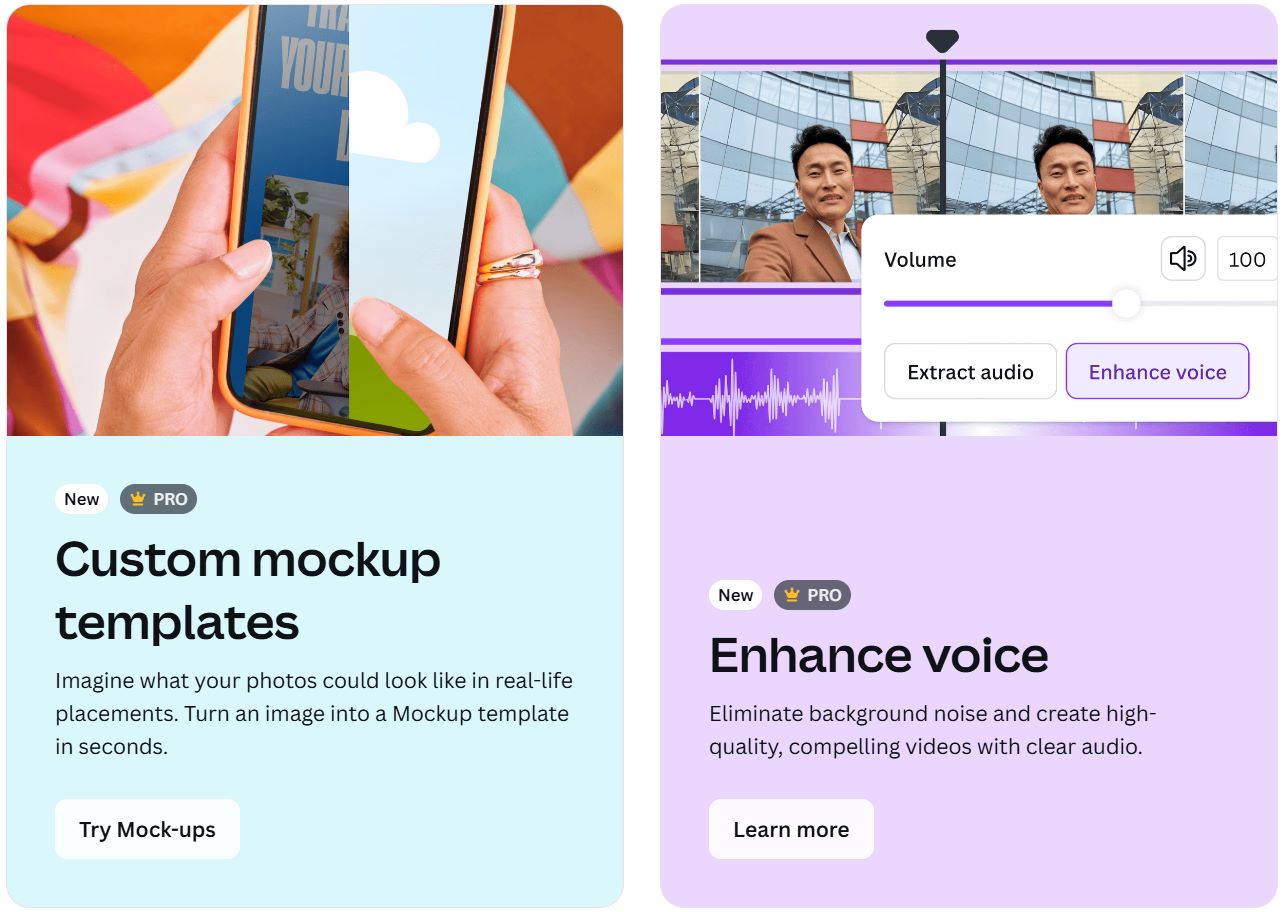
Key Advantages
- Unified AI toolset: All creative AI functions—design, media generation, copywriting, editing, and transformations—accessible in one place
- Beginner-friendly interface: Designed for users without technical expertise or professional design training
- Accelerated productivity: Generate first drafts, design variations, and complete layouts in seconds, dramatically reducing manual work
- Format flexibility: Magic Switch enables instant content reformatting (e.g., document to presentation) and multi-language translation
- Advanced media generation: Create custom images and videos from text prompts using Magic Media and Dream Lab
- Brand consistency tools: Apply your brand kit—fonts, colors, logos—uniformly across all AI-generated assets
- Powered by OpenAI: Built on advanced multimodal AI models including GPT-4 for sophisticated generative capabilities
Limitations to Consider
- Inconsistent output quality: AI-generated designs may require manual refinement; some results can appear generic or contain visual flaws
- Creativity concerns: Over-reliance on AI suggestions may reduce originality and personal creative input
- Feature access restrictions: Many Magic Studio tools are unavailable to Free users and require Pro or Teams subscriptions
- Subscription cost increases: AI tool integration has led to significant price hikes, particularly for Teams plans
- Technical glitches: Users occasionally report Magic Studio features becoming greyed out or disappearing, even with active subscriptions
- Language limitations: AI tools perform best in English; non-English support and translations may produce lower-quality results
Magic Studio Features
Generate complete designs from prompts or uploaded content—images, presentations, videos, and social media visuals.
AI-powered copywriting and content generation integrated directly into Canva docs and design text boxes.
Transform content between formats (document to presentation) or translate designs into multiple languages instantly.
Generate custom images and videos from text prompts using advanced AI image and video synthesis.
Modify specific parts of images—remove or replace objects—using intelligent AI brush tools.
Extend image backgrounds and scenes to create wider canvas compositions seamlessly.
Extract and isolate objects or elements from images for reuse in other designs.
Automatically remove backgrounds or erase unwanted content from images with precision.
Dynamically resize and reorganize content for different formats and aspect ratios automatically.
Apply your brand colors, fonts, and logos uniformly across all AI-generated content.
Access Canva Magic Studio
Getting Started with Magic Studio
Upgrade to Canva Pro or Teams to unlock full Magic Studio features. Free users have limited access to Magic Write and Magic Design with usage credits.
Create a new design or open an existing project in Canva. Look for "Magic" tools and AI options in the editor toolbar (e.g., "Magic Design," "Magic Write").
Use "Design for me" or enter a text prompt describing your desired outcome. Optionally upload images or media to guide the AI generation process.
Use editing tools like Magic Edit, Expand, Grab, or background removal to refine your design. Use Magic Switch to convert between formats or translate content.
Manually edit and fine-tune AI-generated output—adjust layouts, colors, and copy. Apply your brand kit settings to maintain visual consistency.
Download or share your finished design as PNG, JPG, PDF, or video formats. Use smart layouts to resize and adapt content for different platforms.
Important Notes
- Not all AI features are available to Free users—many advanced capabilities require paid Pro or Teams subscriptions
- Canva significantly increased Teams and Pro plan pricing after introducing AI tools, sparking debate about value proposition
- AI-generated designs may require manual cleanup or aesthetic adjustments for professional quality
- AI tools perform best in English; non-English results may have lower quality and require additional editing
- Always review AI-generated outputs for accuracy, potential bias, and copyright considerations before publishing
- Magic Studio is powered by OpenAI models (including GPT-4) while maintaining Canva's user-friendly interface
Frequently Asked Questions
Yes—full access to Magic Studio AI tools requires a Canva Pro or Teams subscription. Free tier users receive limited access to features like Magic Write and trial credits for experimentation.
Magic Design is a core Magic Studio tool that converts text prompts or uploaded assets into polished, professional designs—including images, videos, presentations, and social media visuals.
Magic Switch enables instant content transformation between different formats (e.g., document to slide deck) and provides multi-language translation capabilities for your designs.
Yes. Magic Media and Dream Lab provide advanced generative image and video capabilities—simply enter text prompts to create custom visual content.
Some users report tools being greyed out or disappearing—even with Pro accounts. Try logging out and back in, creating a new design, or contacting Canva support to resolve the issue.
Yes, Canva's terms allow commercial usage of designs and assets created with Magic Studio under its content license. Review Canva's licensing page for complete details.
The Canva interface supports multiple languages, and Magic Switch offers translation features. However, most AI tools perform best in English—non-English results may require additional refinement.
Canva raised subscription costs—particularly for Teams plans—citing the addition of Visual Suite 2.0 and Magic Studio's advanced generative AI capabilities as justification for the price increase.
No, Magic Studio is integrated into Canva's design environment and cannot be disabled. While certain features may be unavailable in lower tiers, you can simply choose not to use them.
Check for awkward layouts, visual glitches, incoherent copy, or misalignment with your brand identity. Always review and refine AI-generated content before publishing to ensure professional quality.
DeepL Translator & Write
| Developer | DeepL SE (Cologne, Germany) |
| Supported Platforms |
|
| Language Support | 37 languages for translation | 6 languages for writing enhancement (English, German, French, Spanish, Portuguese, Italian) |
| Pricing Model | Free tier with limitations | DeepL Pro subscription for advanced features, unlimited access, and API integration |
What is DeepL Translator & Write?
DeepL Translator and DeepL Write form a comprehensive language AI solution from DeepL SE. The translator delivers high-quality neural machine translation (NMT) across multiple language pairs, while Write provides intelligent writing enhancement, rewriting, tone adjustments, and stylistic improvements within the same language.
Together, these tools help users communicate across language barriers and refine their writing with precision. DeepL positions itself as a premium alternative to standard translation tools, emphasizing translation quality, context sensitivity, and seamless integration with business workflows.
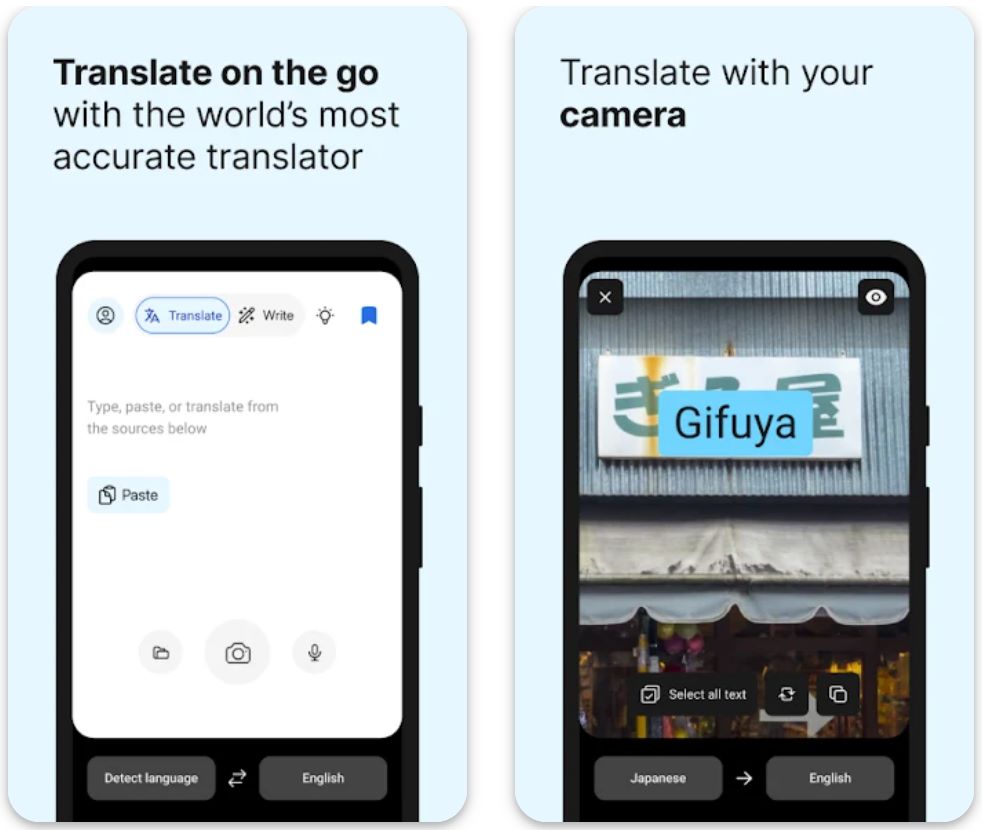
Core Capabilities
DeepL Translator uses advanced neural networks based on transformer and attention architectures, optimized for translation quality, natural phrasing, and context awareness. It supports document translation (PDF, DOCX, PPTX, TXT) while preserving formatting. Users can input text directly or paste blocks for instant translation.
DeepL Write is DeepL's AI writing companion that helps users refine grammar, style, clarity, tone, and rewrite text within the same language. When users input text, Write displays an improved version, highlights changes, and offers alternative suggestions. Write can also convert between language variants (e.g., British ↔ American English).
DeepL Write Pro expands functionality with real-time correction, style and tone selection, and integration into writing apps like Microsoft Word, Gmail, and Google Docs. Through DeepL's API, the writing improvement capability is accessible via the write/rephrase endpoint for users with API Pro plans.
Advantages & Limitations
- Superior translation quality: Widely regarded as more natural and accurate than competitors across many language pairs
- Context-aware processing: Models analyze sentence-level and broader context to reduce literal or awkward translations
- Document translation with formatting: Upload .docx, .pptx, .pdf files and retain structural elements
- Intelligent writing enhancement: Improves clarity, grammar, phrasing, tone adjustments, and rewriting
- Developer-friendly API: Integrate translation and writing improvement into custom applications
- Privacy & security: Pro accounts ensure texts are not stored or used for model training
- Limited Write language support: Write supports fewer languages compared to translation capabilities
- Free tier restrictions: Limited text length, reduced feature access, and no advanced writing features
- Potential translation errors: Idiomatic, domain-specific, or ambiguous sentences may produce awkward phrasing
- API costs: Heavy usage can result in significant API expenses
- Over-reliance risk: Excessive dependence on AI suggestions may reduce careful editing and human judgment
- Regional availability: Some integrations (Write in Word, Gmail) may not be available in all regions or plan levels
Key Features
Translate between 37 supported languages with high accuracy and natural phrasing.
Upload PDF, DOCX, PPTX, TXT files with formatting and structure preserved.
Define custom terms and preferred translations for consistent results.
Grammar correction, style suggestions, rephrasing, and tone adjustments for polished writing.
Rewrite between language variants (e.g., British ↔ American English).
Write Pro integrates with Gmail, Word, Google Docs, and Outlook for seamless workflow.
/translate and /write/rephrase endpoints for translation and writing improvements.
Data encryption with no persistent storage or model training from Pro user content.
Download or Access
How to Use DeepL Translator & Write
Visit the DeepL website, create a free account, or upgrade to Pro for advanced features and unlimited access.
- On web or app, type or paste text, then select source and target languages
- For documents, upload files (PDF, DOCX, PPTX, TXT) to translate with formatting preserved
- Use custom glossary if needed to enforce preferred translations
- Review translated output and make manual edits if necessary
- Enter text into the left panel; the right panel displays an improved version
- Toggle "Show changes" to see what has been modified
- Choose tone, style, or language variants (if available)
- Copy improved text or export for use in your documents
- Use Write in Gmail, Google Docs, Microsoft Word via browser extensions or integrations (if eligible)
- For developers, use the DeepL API to call translation or writing improvement endpoints
Important Notes
- Write support for languages is gradually expanding; advanced features might not be available in all languages or markets
- Translation quality can degrade for highly technical, idiomatic, or context-lacking texts; human review remains important
- API usage may incur costs, rate limits, or quotas depending on your plan
- Write and Translate are separate functionalities: translation is cross-language, Write is monolingual enhancement
- In Pro accounts, DeepL's policies assert that user content is not used to train base models
Frequently Asked Questions
Yes, DeepL offers a free version with limitations (text length, feature restrictions) alongside a Pro paid tier with enhanced capabilities and unlimited access.
DeepL supports translation among 37 languages across major global languages.
Write Pro is DeepL's paid version of the writing assistant, offering real-time corrections, style/tone settings, integrations into writing tools, and enhanced suggestions.
DeepL Write supports English, German, French, Spanish, Portuguese, and Italian (depending on plan/API support).
Yes, DeepL allows translation of PDF, DOCX, PPTX, and other formats while preserving structure, images, and layout as much as possible.
The Write API endpoint is /write/rephrase, which accepts input text and returns improved versions (grammar, phrasing). Available to DeepL API Pro customers.
For DeepL Pro users, DeepL states that texts are not persistently stored or used to train base models.
Requests must not exceed ~10 KiB (10 × 1024 bytes) per call. Larger texts must be split into smaller segments.
Yes. Through the API, you can supply a "context parameter" to help improve translation accuracy for shorter texts or ambiguous content.
You may be blocked or required to upgrade to Pro for continued access to advanced features or higher usage limits.
They are helpful but should be reviewed—especially for specialized domains, nuance, and tone. Human judgment remains essential for critical content.
Obtain an API key, use official SDKs (Python, Node, etc.), send HTTP requests to /translate or /write/rephrase endpoints, observe usage limits, and parse JSON responses.
Reclaim.ai (AI Scheduler)
| Developer | Reclaim, a software startup specializing in AI-powered calendar optimization and time management automation |
| Supported Platforms |
|
| Language Support | English interface, available globally wherever Google Calendar and Outlook are accessible |
| Pricing Model | Free Lite plan available. Paid plans: Starter (~$8/user/month), Business (~$12/user/month), and Enterprise (custom pricing) |
What is Reclaim.ai?
Reclaim.ai is an AI-powered scheduler that automates calendar management for tasks, focus time, meetings, habits, and breaks. It works as an intelligent layer on top of your existing Google Calendar or Outlook Calendar to defend your time, resolve scheduling conflicts, and optimize your workweek. The platform claims to recover up to 40% of your workweek by intelligently organizing your schedule based on priorities.
Rather than replacing your calendar, Reclaim acts as a smart assistant that ensures you allocate time for priorities, avoid burnout, and reduce calendar friction through automated scheduling decisions.
How Reclaim.ai Works
Reclaim uses AI to continuously monitor your calendar events, tasks, habits, and scheduling rules to automatically place, move, and reschedule items based on your defined priorities.
You assign priority levels (Critical, High, Medium, Low) to events, tasks, or habits, and Reclaim respects those priorities when deciding which items can flex or shift during conflicts. If scheduling conflicts arise, Reclaim automatically reschedules lower-priority items to protect higher-priority ones.
Automatically schedules tasks directly into calendar slots based on deadlines and availability
Manages recurring habits by finding flexible slots around your existing calendar commitments
Protects blocks for deep work by automatically rescheduling less urgent items around them
Automatically schedules group meetings across multiple attendees with intelligent conflict resolution
Schedules buffer times and travel time between events to reduce back-to-back stress
Dynamically adjusts your calendar when new meetings or tasks emerge
Key Advantages
- Time regained: Automates calendar adjustments, freeing you from manual scheduling juggling
- Priority-driven scheduling: Ensures critical items are protected from displacement
- Conflict resolution: Real-time auto-rescheduling when meetings or new tasks emerge
- Habit & task integration: Embeds recurring routines and spontaneous tasks intelligently
- Breaks & buffer time: Automatically prevents calendar burnout with smart spacing
- Extensive integrations: Works with Google Tasks, Asana, ClickUp, Linear, Jira, Slack, Zoom, and more
- Scalable for teams: Team analytics, seat management, SSO, and enterprise security features
Potential Limitations
- Learning curve: Requires time to configure scheduling rules and priority settings optimally
- Limited project management: Focuses on scheduling rather than full project/task tracking or dependencies
- Calendar platform dependency: Relies entirely on Google Calendar or Outlook functionality and limitations
- Potential override issues: Automatic rescheduling may move events unexpectedly if priorities aren't finely tuned
- Feature gating: Many advanced features locked behind paid plans (multiple smart meetings, advanced analytics)
Core Features
Auto-schedule recurring or group meetings across attendees with conflict resolution and intelligent rescheduling
Share availability slots via customizable links with rules, round-robin, and priority settings
Blocks of deep work time that AI actively defends within your schedule
Converts tasks into smart calendar blocks considering deadlines and availability
Recurring routines scheduled flexibly (exercise, lunch) with automatic conflict rescheduling
Automatically inserts breaks or travel time between events
Lower-priority items shift automatically to make space for higher-priority ones during conflicts
Syncs across Google and Outlook calendars to prevent double booking
Time tracking, team analytics, meeting load reports, work-life balance metrics
Assign priority (P1 to P4) and custom rules to influence scheduling behavior
Reserve full days without meetings and auto color code events by type
Sync tasks from Asana, ClickUp, Jira, Linear; reflect status in Slack automatically
Download or Access Link
Getting Started Guide
Visit Reclaim.ai's website and register for an account (free Lite plan available). Connect your Google Calendar or Outlook Calendar to allow Reclaim to read and write events.
Define priority levels for Tasks, Habits, Smart Meetings, and non-Reclaim events (Critical → Low). Set how far ahead Reclaim should schedule (note: free plan has limited scheduling range).
Turn on Focus Time, Smart Meetings, Scheduling Links, Habits, and Buffer Time in your settings. Integrate with task tools (Asana, ClickUp, Todoist, etc.) and Slack for status sync.
Add tasks, habits, or meetings as smart events. Reclaim will automatically pick optimal times. Use scheduling links so others can book time with you while respecting your constraints.
When calendar conflicts appear, Reclaim dynamically moves lower-priority items to preserve your most important slots automatically.
Check your weekly calendar and recommended placements. Adjust settings or priorities if the output doesn't match your preferences.
Use time tracking and team-level analytics to spot over-meeting, burnout risks, or productivity gaps. In team plans, leverage seat management, SSO, and provisioning features.
Important Notes
- Auto-rescheduling may lead to unexpected shifts if priority or rules aren't finely tuned (based on user feedback)
- Project management features like dependencies, Gantt charts, or advanced task workflows are outside Reclaim's scope
- Reclaim's accuracy in rescheduling and placement depends on the cleanliness and constraints of your calendar data
Frequently Asked Questions
Yes. Reclaim offers a Lite plan that is free forever, providing basic time-blocking, a single smart meeting, one scheduling link, and basic integrations.
- Starter: ~$8/user/month, supports up to 10 seats, multiple smart meetings, extended scheduling range
- Business: ~$12/user/month, up to 100 seats, unlimited smart meetings, advanced features
- Enterprise: Custom pricing with security, SSO, SCIM, audit logs, domain controls
Reclaim supports Google Calendar and Outlook Calendar.
Yes—through Scheduling Links and Smart Meetings, Reclaim can schedule meetings involving external participants while respecting your calendar constraints.
Reclaim monitors conflicts and can move lower-priority events to make space for higher-priority ones. It evaluates priorities, availability, and rules to make smart rescheduling decisions automatically.
Yes. You can create tasks or habits that Reclaim will schedule dynamically into your calendar, adjusting based on deadlines and availability.
Yes. Paid tiers include analytics for individual and team-level metrics on time spent in meetings, productive work, meeting load, and work-life balance.
You may be prevented from creating additional smart meetings or scheduling links unless you upgrade your plan.
Reclaim's public documentation and interface are primarily in English. Multilingual support is not prominently documented.
- Sign up and connect your calendar
- Define your priority rules and scheduling preferences
- Activate smart events (focus, tasks, meetings)
- Let Reclaim manage conflicts automatically
- Review weekly output and refine settings as needed
Transform Your Workflow with AI
A new generation of AI office tools is making daily work faster and smarter. From integrated assistants in major office suites to specialized applications, these innovations are reshaping workplace productivity.




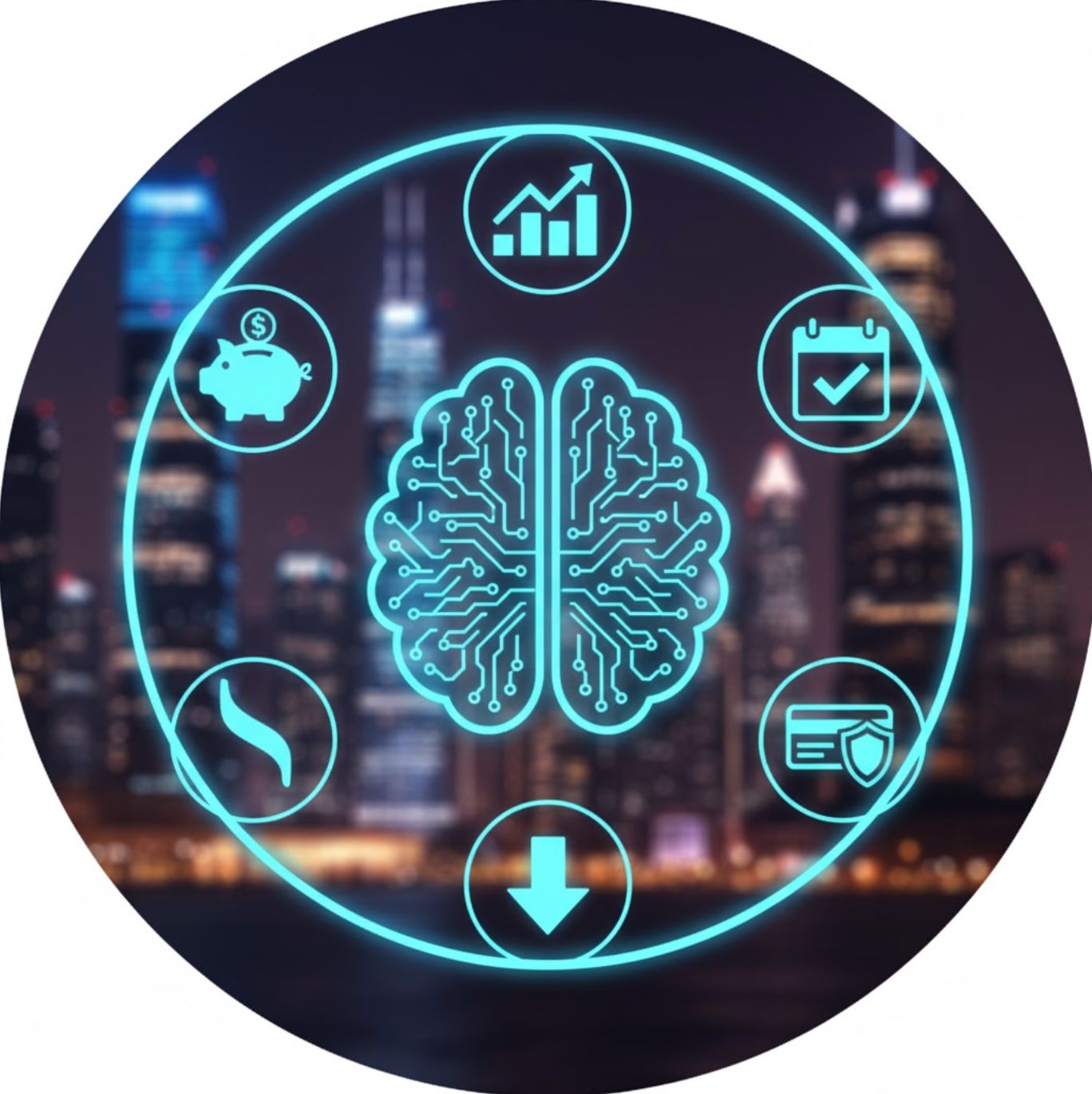


Comments 0
Leave a Comment
No comments yet. Be the first to comment!